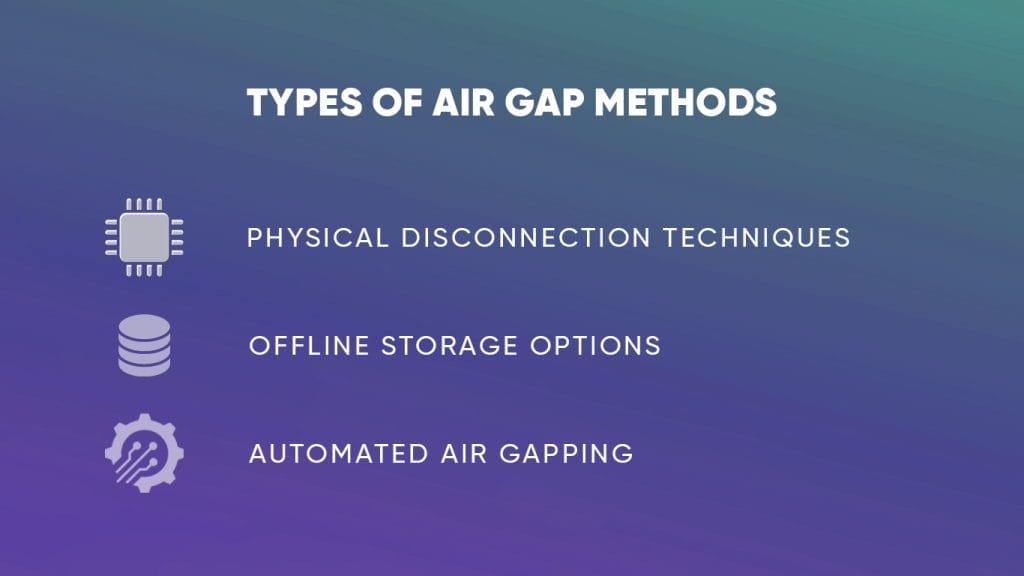
Air gap backups, which involve the physical isolation of backup data from any network connectivity, provide robust protection against cyber threats by ensuring that critical information remains inaccessible to online attacks. By disconnecting storage devices, either physically or logically, such systems preserve data integrity and enhance security measures. These backups are particularly essential for compliance with industry regulations like GDPR, HIPAA, and PCI DSS, minimizing risks of breaches and ensuring data recoverability in disaster situations. With suitable backup hardware and meticulous implementation, air gapping can be a crucial component of a thorough data protection strategy. Further exploration will reveal more about optimizing these systems for your needs.
Key Takeaways
- Air-gap backup involves physically isolating data to protect against cyber threats and unauthorized access.
- Common methods include offline storage and automated air gapping for enhanced data security.
- Tools like Veritas NetBackup and Veeam Backup & Replication facilitate secure and scalable air gap backups.
- Air gapping ensures compliance with regulations like GDPR and HIPAA by securely isolating sensitive data.
- Although highly secure, air gap backups can be costly and complicate timely data recovery due to their disconnected nature.
Understanding Air Gap Backups

To effectively secure your critical data, air gap backups physically isolate backup data from your main network, safeguarding it from unauthorized access and cyber threats. This security measure is paramount, especially for organizations facing high-security demands. By implementing a physical air gap, you’re not just protecting your data; you’re guaranteeing a robust defense against increasingly sophisticated cyber attacks, such as ransomware.
Air gap technique serve as a crucial component of your overall backup and disaster recovery strategy. They provide a fail-safe by maintaining a copy of your data completely disconnected from the network. This separation dramatically reduces the risk of digital threats reaching your important records. Without a direct connection to the internet or other networks, the chance of malicious intrusions is greatly minimized.
Opting for air gap backups isn’t just about security; it’s about peace of mind. Knowing that your data is stored securely off-network means that, in the event of a cyber incident, you have a reliable recovery point. This guarantees not only the continuity of your operations but also compliance with various regulatory requirements that demand strict data protection measures.
Embrace air gap backups as a proactive approach to secure and protect data effectively.
The Mechanics of Air Gapping for Data Protection
You’ll first need to understand that the process of air gapping involves a straightforward yet critical procedure: the physical isolation of backup devices.
Once the backup is complete, these devices are disconnected from any network, effectively preventing any online threats from compromising the data.
This method not only secures your data from cyber-attacks but also preserves its integrity by minimizing the risk of unauthorized access or corruption.
Explanation of the process
Understanding the mechanics of air gapping starts with recognizing its primary function: physically isolating your backup data from the main network to enhance security. This data protection strategy involves implementing an air gap backup, where you’ll store critical data on offline devices such as external hard drives or tape drives. It’s essential that these devices remain completely disconnected from any network after the backup is performed.
You’re effectively creating a physical barrier—physical air gapping—which shields your backup data from cyber threats like ransomware attacks or data corruption. By keeping your backup offline, you guarantee that no unauthorized access or online threats can compromise your data. This method is particularly valuable for organizations with stringent security requirements, as it provides a robust layer of defense against potential breaches.
The process of air gapping as part of your backup and recovery plan not only secures your data but also aids in regulatory compliance, offering peace of mind.
You’ll find that disconnecting and securing the backup device is a critical step, ensuring that your data isn’t just backed up, but is truly secure and retrievable in its original, uncorrupted form when needed.
Technical details
Air gapping achieves enhanced security by physically isolating your backup data from the main network, guaranteeing no unauthorized access can compromise the stored information. By keeping your backup environment completely offline, you’re not just protecting against cyber threats; you’re also creating an immutable backup that remains untouched and pristine, safeguarding the integrity of your data.
Here’s how it works: you’ll store your critical data on a separate physical device that isn’t connected to any network. This physical air gap means that even if your main network is compromised, the air gapped system remains secure and unaffected.
The effectiveness of this setup hinges on maintaining strict physical and procedural barriers between your online systems and the offline backup devices.
It’s essential that you handle these devices with care. Only authorized personnel should have access to the air gapped backup, and strict protocols must be in place for when and how these devices are updated or accessed. By adhering to these guidelines, you secure that the backup remains an effective tool for recovery, free from the threats that plague connected systems.
This approach isn’t just about technology; it’s about creating a fortress around your most valuable data.
Types of Air Gap Methods

You’ll encounter several effective types of air gap methods as you explore ways to enhance your data security.
Physical disconnection techniques guarantee your backups are completely isolated from the network.
Offline storage options offer a tangible and secure method to store critical data away from potential cyber threats.
Physical Disconnection Techniques
Different air gap methods provide various levels of physical and logical disconnection to safeguard your data effectively. You’ll find that physical air gaps involve complete physical separation of devices, ensuring they’re not connected to any network, thereby limiting any potential unauthorized access. Logical air gaps, on the other hand, aren’t physically disconnected but use robust security measures like firewalls and encryption to create a barrier.
Air gap clouds are an innovative approach, where data is stored in cloud environments specifically designed to be inaccessible via the internet. These methods, along with specific isolation techniques, guarantee that your sensitive information remains untouched and secure from cyber threats.
Here’s a breakdown of the key elements:
| Method | Description |
| Physical Air Gap | Devices completely disconnected from any networks. |
| Logical Air Gap | Uses software like firewalls to prevent unauthorized access. |
| Air Gap Clouds | Data stored offline in secure cloud services. |
| Security Measures | Includes digital protections such as encryption. |
| Isolation Techniques | Ensures data is kept offline to avoid compromises. |
Understanding these methods helps you choose the right type of air gap backup strategy to protect your data.
Offline Storage Options
Exploring offline storage options, such as physical and logical air gaps, can greatly enhance your data’s security. By understanding the different offline storage methods available, you’ll be better equipped to protect your sensitive information from cyber threats.
Here are three key types of air gaps you should consider:
- Physical Air Gap: This method involves physically isolating storage devices from any networks. Data is transferred to these devices and then completely disconnected from the internet or any other networks. It’s a robust solution to prevent remote attacks since there’s no direct pathway for hackers to access the isolated data.
- Logical Air Gap: Unlike the physical separation, a logical air gap utilizes software configurations to segregate data. Techniques include encryption and specialized protocols that simulate an air gap environment within a connected infrastructure. This method protects against unauthorized access while allowing a degree of connectivity.
- Air Gap Clouds: Some cloud service providers offer air gapped cloud storage, ensuring that copies of your data are stored in a way that they’re physically or logically isolated from the internet. This combines the convenience of cloud storage with the security benefits of air gapping.
Protect your Data through Automated Air Gapping
As we consider offline storage options, let’s now focus on how automated air gapping enhances data security through both physical and logical means.
Automated air gapping isn’t just about unplugging devices; it’s a sophisticated strategy that includes both physical and logical separations to safeguard your data.
Physical air gapping involves isolating your backup systems from any network. Think of it as locking your data in a vault where no online threats can reach it. This method is straightforward but highly effective at protecting against cyber threats.
On the other hand, logical air gapping uses software solutions to create barriers that aren’t as visually obvious but are equally crucial. Here, you’ll find encryption playing a pivotal role. By encrypting your data, you ensure that even if someone were to breach the perimeter defenses, the stolen data would remain unreadable.
Firewalls also play a significant role in this setup, acting as gatekeepers to block unauthorized access.
Together, these methods form a robust defense mechanism. Whether you’re dealing with sensitive financial records or personal client information, relying on automated air gapping provides a secure foundation.
It’s not just about keeping your data offline; it’s about ensuring that when the worst happens, you’re prepared.
Implementing Air-Gapped Backup

As you embark on implementing air gap backups, you’ll first need a step-by-step guide to guarantee each phase of the process is handled correctly and securely.
You’ll also benefit from recommendations on the best tools and software that can facilitate this critical task.
These resources are essential for effectively isolating your data and protecting it from today’s sophisticated cyber threats.
Step-by-step guide to backup data
To implement air gap backups effectively, you’ll first need to identify the critical data that requires protection. This step is vital as it guarantees that your most valuable information is safeguarded during disaster recovery.
Once identified, you need to select a secure storage medium and appropriate backup software.
Here’s a straightforward guide to get you started:
- Choose Your Backup Medium: Opt for secure, immutable storage options like external hard drives or magnetic tape drives. These are ideal for air-gapped environments as they can be easily disconnected and are less vulnerable to cyber threats.
- Backup Your Data: Utilize reliable backup software to copy your critical data onto the chosen medium. Ensure that the backup process is thorough and that all essential data is included. This step is essential for maintaining the integrity and availability of your backup data.
- Disconnect and Store Securely: Once the backup is complete, disconnect the storage medium from any network connections. Store it in a secure, offsite location to maximize air gap security. This physical separation protects your backup from online threats and unauthorized access.
Tools and software recommendations
You’ll find that tools like Veritas NetBackup, Veeam Backup & Replication, and Acronis Cyber Backup are popular choices for implementing air gap backups, thanks to their robust security features. Each of these platforms offers unique functionalities that cater to diverse data protection needs while ensuring your backups remain secure and isolated from potential cyber threats.
Veritas NetBackup excels in environments requiring high scalability and centralized management. It integrates data deduplication, which greatly reduces storage needs by eliminating redundant data, making it a cost-effective solution for large organizations. Moreover, its advanced encryption capabilities ensure that your data remains secure, whether at rest or in transit.
Veeam Backup & Replication stands out for its ease of use and extensive support for virtual environments. With powerful automation tools and real-time monitoring, Veeam ensures your backup processes are both efficient and secure. The software’s ability to quickly restore operations is particularly valuable for minimizing downtime during a data recovery scenario.
Acronis Cyber Backup is renowned for its user-friendly interface and robust security measures, including active protection against ransomware. Its fast recovery options and flexible storage compatibility make it an ideal choice for businesses looking for reliable and secure backup solutions.
Choosing the right tool for your air gap backup strategy is essential for ensuring the utmost protection of your critical data.
Benefits of Air Gapping

=
You’ll find that air gap backups enhance your data security greatly, as they physically isolate sensitive information from potentially compromised networks.
They also guarantee that you remain compliant with industry regulations by safeguarding critical data.
Moreover, this method facilitates reliable data recovery, providing a robust solution in data backup and disaster recovery scenarios.
Enhanced Data Security
Air gap backups greatly enhance your data security by physically isolating backup data from the main network. By incorporating air gapping into your backup strategy, you’re taking a substantial step to secure your data and provide a robust defense against data loss. This method of data protection isn’t just about keeping your digital assets safe from cyber threats; it’s about ensuring that you have reliable, untampered access to your information when you need it most.
Here are three key reasons why you should consider air gap backups:
- Protection Against Cyber Threats: Air gapping effectively shields your backup data from ransomware and other malware types. Since the backup device isn’t connected to the internet or any network, attackers can’t access it remotely.
- Preservation of Data Integrity: Without a direct connection to potentially compromised networks, your data remains in its original state—safe from corruption, accidental deletions, or unauthorized alterations.
- Immediate Recovery Capabilities: In the event of a data compromise on your main network, air gapped backups are readily accessible. You can restore your systems quickly, minimizing downtime and operational disruptions.
Incorporating air gap backups into your overall security plan is a proactive approach that significantly mitigates risks associated with digital data management.
Regulatory Compliance Assurance
Ensuring your organization meets stringent regulatory standards often requires air gap backups, as these systems provide important isolation of sensitive data from online threats. By integrating air gap backups into your data protection measures, you’re not just safeguarding sensitive data; you’re also aligning with compliance standards set forth by GDPR, HIPAA, and PCI DSS. These regulations mandate rigorous data security practices, and air gapping serves as a robust compliance tool.
When you employ air gap backups, you’re creating a physical barrier between your sensitive data and potential cyber threats, which directly supports your regulatory compliance efforts. This separation ensures that your data isn’t accessible via the internet, thereby significantly reducing the risk of breaches and unauthorized access. As a result, you’re not only protecting your organization from data loss but also from costly fines and penalties associated with non-compliance.
Industries such as healthcare, finance, and legal often find themselves under intense scrutiny regarding data privacy and security. For these sectors, air gap backups aren’t merely an added security measure but an essential component of their compliance strategy. By maintaining these backups, you ensure continuous adherence to legal requirements and protect your organization’s integrity and reputation.
Reliable Data Recovery
While regulatory compliance is vital, it’s equally important to recognize how air gap backups facilitate reliable data recovery in the face of potential disasters.
As you weigh your options for enhancing your organization’s data security, consider these core benefits of air gap backups:
- Physical Isolation: Air gap backups guarantee that your critical data is stored on devices that are physically isolated from your main network. This physical separation safeguards your backups from cyber threats, including ransomware, providing dependable data recovery when you need it most.
- Protection Against Ransomware: By preventing any network access to your backup data, air gap backups shield against ransomware attacks. Even if your primary systems are compromised, these backups remain untouched, ensuring that your data can be restored to its original state without paying a ransom.
- Extra Layer of Assurance: Implementing air gap backups adds an additional layer of assurance to your data security measures. This approach not only meets strict regulatory compliance requirements but also gives you peace of mind knowing that your data is recoverable under almost any circumstances.
Incorporating air gap backups into your data protection strategy is a proactive step towards ensuring reliable data recovery, safeguarding your most valuable assets from unforeseen disasters.
Common Criticisms of Air Gapping
As you evaluate the viability of air gap backups, you’ll find that critics often highlight a few significant drawbacks.
The cost implications, for instance, aren’t trivial; maintaining physical and logical security measures can be quite expensive.
Additionally, you might face accessibility challenges and complex implementation processes, which can deter some organizations from adopting this method.
Cost Implications Explored
Considering air gap backups can greatly increase your organization’s expenses regarding both hardware investment and ongoing maintenance. Delving into the cost implications, you’ll find that this strategy demands a substantial financial commitment and should be viewed as a long-term investment.
Here are a few key areas where your expenses will significantly increase:
- Operational Expenses: The process of implementing air gap backups isn’t only time-consuming but also requires additional manpower. This can lead to higher operational costs as more staff or specialized personnel might be necessary to manage and maintain the system effectively.
- Secure Storage Facilities: To safeguard the physically isolated backup devices, investing in secure storage facilities becomes imperative. These facilities need to be well-protected against physical threats, which can add a significant expense to your budget.
- Hardware and Software Costs: The initial setup for air gap backups involves purchasing dedicated backup devices and possibly specialized software. This upfront cost, combined with the need for regular updates and maintenance, contributes to the overall financial strain.
Each of these factors must be carefully considered to determine if the security benefits of air gapping justify the associated costs for your organization.
Accessibility Challenges
Air gap backups, though secure, often hinder timely data recovery due to their disconnected nature. You might find that accessing your critical data becomes a challenge, especially when you’re racing against time in a disaster recovery scenario. The physical air gap, while an excellent barrier against cyber threats, introduces notable accessibility challenges that can make the recovery process time-consuming and cumbersome.
The very essence of air gapping—disconnecting backups from the network—means that retrieval isn’t as simple as accessing a file on a connected device. You’ll need to physically interact with the backup storage, possibly requiring you to be on-site or to manually handle the storage media. This can considerably slow down your recovery efforts when rapid response times are important.
Moreover, the additional security measures necessary for maintaining the integrity of a physical air gap system further complicate accessibility. Each layer of security, designed to protect your data from unauthorized access, also adds steps to the recovery process.
As you plan your backup strategy, it’s important to weigh these factors carefully. While ensuring data security, you must also consider how these measures impact your ability to quickly and efficiently recover data when needed.
Implementation Complexity
Implementing air gap backups often presents complexities due to the need for strict physical and logical separations. You’ve got to manage multiple layers of security, all while ensuring compliance with various regulations. The nuances of setup and maintenance can catch you off guard if you’re not fully prepared.
Here are some key challenges you’ll face when it comes to the implementation complexity of air gap backups:
- Physical Separation: Maintaining a complete disconnect between your primary data and backup systems is vital. Yet, this very separation can introduce logistical hurdles. You’ll need secure spaces and robust procedures to prevent unauthorized access, adding layers of complexity to your security strategy.
- Security Risks: Despite the solid protection offered, the physical structure necessary for air gapping can pose its own security risks. Any lapses in protocol or physical breaches can undermine the entire system, making vigilance and regular audits essential components of your strategy.
- Regulatory Compliance: You’re also managing the tricky waters of regulatory compliance. Ensuring that your air gap method meets industry standards isn’t just about setting it up once; it’s about continuous adherence and updates in line with evolving laws and guidelines.
Balancing these elements requires a thoughtful approach to network connectivity, data sensitivity, and employee trust.
Air Gap Backups vs Online Backups

An air gap backup system, employing an air wall, ensures robust data security by physically isolating backup storage from network connections, effectively shielding data from cyber threats and ransomware attacks.
When considering air gap backups versus online backups, you must weigh their respective advantages and disadvantages to determine which strategy best suits your needs.
Air gap backups offer superior protection from cyber threats by keeping your critical data offline, but they can be cumbersome and less accessible than their online counterparts.
On the other hand, online backups provide convenience and real-time data availability, yet they expose you to higher risks of cyber attacks due to their connectivity to the internet.
Comparison of Advantages and Disadvantages
When evaluating the options between air gap backups and online backups, you’ll need to take into account several key points: the enhanced security benefits, implementation cost analysis, and recovery time considerations.
Air gap backups offer superior protection against cyber threats, but they may come with higher initial costs and longer recovery times compared to online solutions.
On the other hand, while online backups provide ease of access and lower upfront expenses, they’re more susceptible to cyber attacks and data breaches.
Enhanced Security Benefits
Air gap backups greatly enhance security by physically isolating your data, starkly reducing the risk of cyber attacks compared to online backups. Here’s why they’re essential:
- Ransomware Resistance: Air gap backups deny ransomware the physical access it needs to encrypt your files.
- Robust Data Protection: These backups act as a critical layer of protection, fortifying your data integrity.
- Exclusive Control: You maintain sole access, preventing unauthorized tampering.
Implementation Cost Analysis
While air gap backups greatly enhance your data security, it’s important to take into account their financial implications compared to online backups.
Air gap backups involve higher initial costs due to the need for physical storage devices and dedicated offline systems.
You’ll find that these implementation costs can be significant, especially when balancing the benefits of heightened security against the expenses involved.
Recovery Time Consideration
You’ll notice that air gap backups typically have longer recovery times than online backups due to the need for manual intervention during the data retrieval process.
Consider the following:
- Online backups provide quicker data access.
- Physical intervention is necessary with air gap backups.
- Enhanced data security against ransomware is a significant advantage of air gap backups despite slower recovery time.
Choosing the Right Backup Strategy
Deciding between air gap backups and online backups depends on how you weigh security against convenience. If you’re prioritizing a robust protection strategy for your data storage, air gap backups might be the right choice. This method involves creating air-gapped data storage, where backup data is physically separated from your network and stored offline. This separation shields your backups from cyber threats, including ransomware attacks, providing a high level of security.
On the other hand, if regular access to backups and ease of data sharing are paramount, online backups could be more suitable. These backups store your data on remote servers that are accessible via the internet. While convenient, they’re potentially vulnerable to cyber attacks, as they remain connected to the internet.
Consider your organization’s specific needs. For instance, if you handle sensitive information or comply with stringent regulatory requirements, the enhanced security of air gap backups might outweigh the convenience of online backups.
However, for businesses that need frequent access to backup data for operational continuity, the immediacy provided by online backups could be critical. Ultimately, your choice should balance these factors to align with your overall business strategy and risk management protocol.
Future of Air Gap Technology
Air gap technology is poised to evolve greatly, incorporating advancements in encryption and secure data transfer protocols. As you look toward the future of air gap technology, you’ll find that several key developments are set to redefine how your data is protected. Here’s what you can anticipate:
- Enhanced Encryption Methods: Future systems will employ even more sophisticated encryption methods to secure data transfers in and out of the air gap environment. This will guarantee that sensitive information remains protected against interception or breaches.
- Robust Authentication Mechanisms: To access air-gapped systems, enhanced authentication mechanisms will be critical. You’ll see multi-factor and biometric verification techniques becoming standard to prevent unauthorized access.
- Scalable Data Storage Solutions: As data volume grows, so does the need for scalable storage solutions that can handle the influx without compromising security. Next-generation air gap backups will offer modular, expandable storage options to meet this demand.
These advancements won’t only improve security but also enhance the efficiency of data recovery and management in air gap environments. By staying informed and prepared, you can make certain that your data protection strategy remains robust against evolving cyber threats.
Frequently Asked Questions
What Is the 3 2 1 Backup Rule?
The 3-2-1 backup rule means you’ll keep three copies of your data, store them on two different media types, and maintain one copy offsite to protect against data loss and disasters.
Can Air-Gapped Systems Be Hacked?
Yes, you can hack air-gapped systems. Techniques like physical access, social engineering, or infected USBs breach these isolated systems. It’s essential to maintain strict security protocols to mitigate these vulnerabilities effectively.
Are Air-Gapped Backups Immutable?
Yes, air-gapped backups are generally immutable because they’re physically isolated from the network, preventing unauthorized access and ensuring that your stored data can’t be altered or deleted by external threats.
What Type of Protection Does an Air Gap Provide?
You’re asking about the protection air gaps offer. They provide robust security by isolating backup data from the network, shielding it from cyber threats like ransomware, ensuring data integrity and compliance.
Conclusion

In the digital domain, air gap backups are akin to the drawbridges of ancient castles, diligently raised to protect the kingdom’s treasures—your data—from the marauding hordes of cyber threats.
As you’ve seen, implementing these backups effectively fortifies your data’s security, ensuring compliance and accessibility despite the evolving landscape of digital warfare.
By embracing this venerable yet sophisticated method, you equip your organization with a resilient defense against the inevitable onslaughts, safeguarding your invaluable digital assets for the future.
For data protection services, you may reach out Computronix your expert it support provider in Stamford, that also serve nearby areas.










